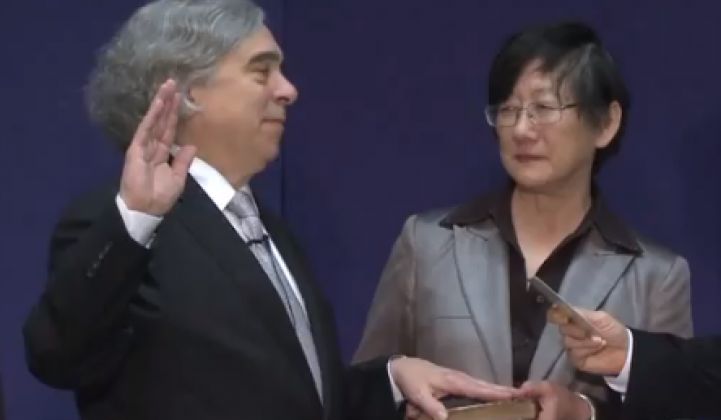Dr. Ernest J. Moniz just delivered his first big policy address since being sworn in as the 13th U.S. Secretary of Energy in May. He spoke at Columbia University's Center on Global Energy Policy in New York City on Monday afternoon.
Secretary Moniz set the Obama administration's Climate Action Plan as the backbone of his speech and set the stage for his tenure at the DOE.
Here's the gist of the speech.
Grid Resilience
The first thing Moniz brought up was Hurricane Sandy, its impact on energy infrastructure, and the need for "resilience" on the grid. He said, "We have to help this rebuilding in a smart way."
Preparing for a Changing Climate
The Energy Secretary was not wishy-washy on the topic of climate change. He cited the increase in extreme weather events and said, "These recent events, unfortunately, are likely harbingers of things to come, scenes that will likely be repeated as carbon emissions from human activity threaten to alter the global climate consistent with the longstanding expectations of the climate science community."
He said, "I'm not here to debate what's not debatable. The evidence is overwhelming. The science is clear -- certainly clear for the level that one needs for policymaking -- in terms of the real and urgent threat of climate change."
The Secretary added, "The overwhelming conclusion, certainly for the policy world, is that prudence demands strong, commonsense, near-term policy actions to minimize the risk of global warming -- and that's what the president's Climate Action Plan does in the absence of legislative remedies."
A Focus on Energy Efficiency
Moniz noted that his first official event as Secretary was an Alliance to Save Energy meeting and that efficiency remains crucial in taming CO2. He spoke of an improved dialogue between DOE and OMB that has helped speed enactment of new appliance efficiency rules for ovens, metal halide lamps, commercial walk-in coolers, and electric motors. Expect more appliance efficiency rules from the Moniz DOE.
Cutting Emissions From New and Existing Power Plants
Moniz tackled the issue of fossil fuels, saying, "Another key provision of the president's Climate Plan directs EPA to issue rules for cutting carbon emissions from both new and existing power plants. The power sector is the single largest source of CO2 emissions in the United States, and as such, this action has been applauded by many as the most significant step the president can take to reduce carbon emissions, absent legislative action. This directive has also been derided by some as an action that is tantamount to a war on coal."
He rejected that claim.
"We must reduce CO2 emissions. [...] 'All-of-the-above' means we will invest in the technology -- research, development and demonstration -- so that all of our energy sources can be enabled as marketplace competitors in a low-carbon energy world."
He spoke of carbon capture and sequestration (CCS) and the up to $8 billion in loan guarantees to demonstrate new fossil fuel technologies. He said, "This is not a war on coal. It is preparing the way for coal to potentially have a place in the low-carbon world."
A Successful Loan Guarantee Program
Moniz said that despite the reflex to think "Solyndra" when the term "DOE loan guarantee" is mentioned, the loan program has supported "a large and diverse $34 billion portfolio" of wind, solar, nuclear and automotive ventures. Moniz noted the program's New York connections in Richard Kauffman and Peter Davidson, and hailed some of the program's accomplishments:
- Jump-starting utility solar in the U.S.
- Manufacturing the Tesla Model S (which he called "pricey" but an appropriate business model at this stage of the market). Tesla has paid its loan back early.
- Providing a provisional loan guarantee for the first permitted U.S. nuclear plant in decades
"The portfolio was supposed to take some risks; not every investment is going to succeed. The track record is quite remarkable," said Moniz.
Driving Down the Cost of Low-Carbon Solutions
Moniz cited the recent cost reductions in wind power, solar panels, EV batteries, and LED lighting.
"A harbinger of what is coming is when energy incumbents start to seriously reexamine their business models in the face of what is happening," said Moniz, citing the current "discussions" on how power from distributed PV systems is valued. "It was only a few years ago when nobody cared. The message is the future may not be always ten years away. I believe these technologies are beginning to establish their positions."
Microgrids, Resilience and Developing 21st Century Infrastructure
The Secretary noted that before making this speech, he was in Secaucus, N.J. signing an MOU with Governor Christie and the New Jersey Transit Association to develop a 50-megawatt microgrid. He called it "a perfect model of rebuilding" and returned to his earlier theme of building grid resilience in the face of extreme weather and cyberthreats.
Q&A
During the question-and-answer session, the Secretary diplomatically responded to questions on natural gas export permits and nuclear power, as well as some heckling on the issue of fracking. He spoke of the substitution of natural gas for coal as being a bridge to renewables. He noted that during his time at MIT, the answer to the question of whether natural gas was a problem or the solution was "Yes."



